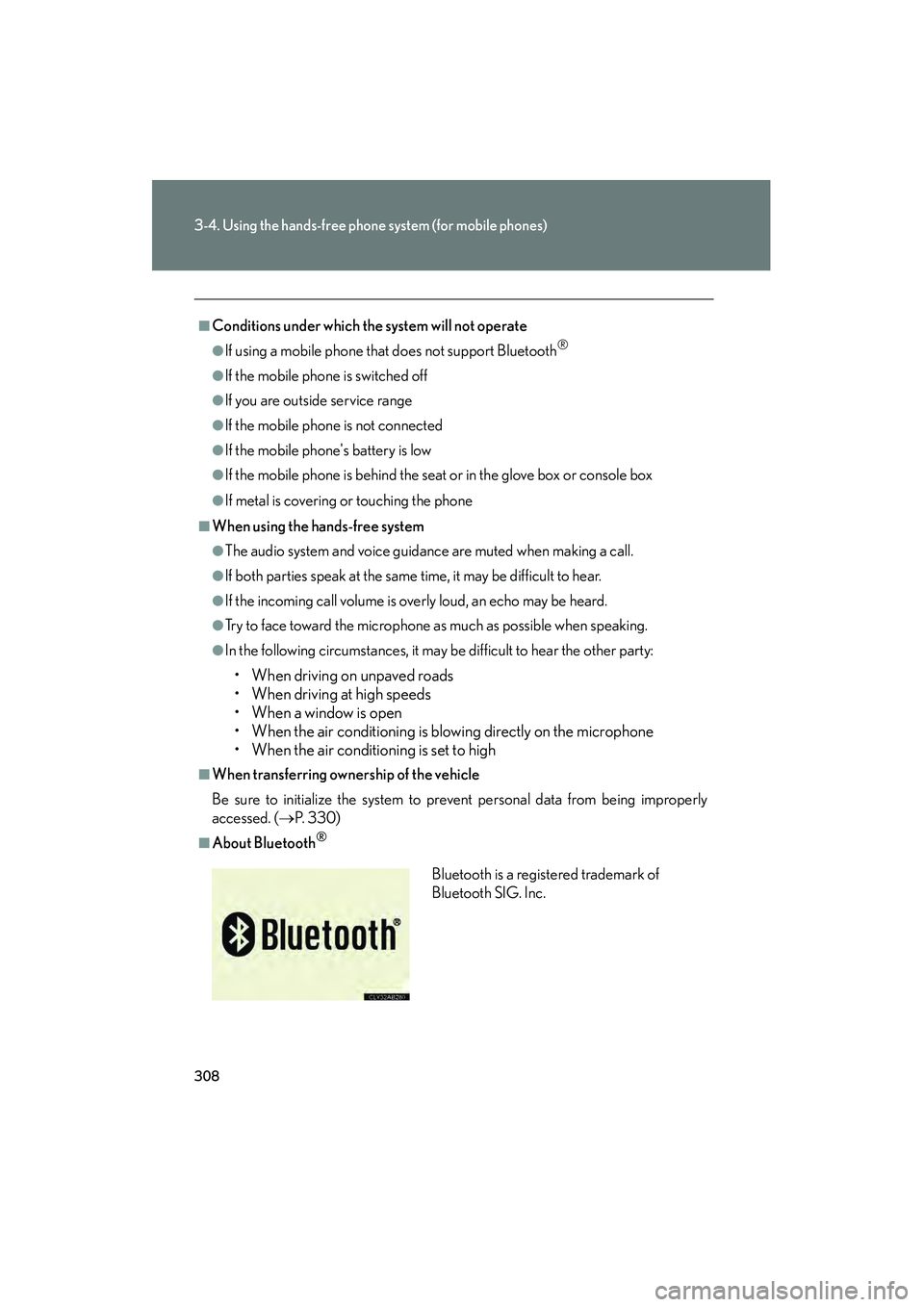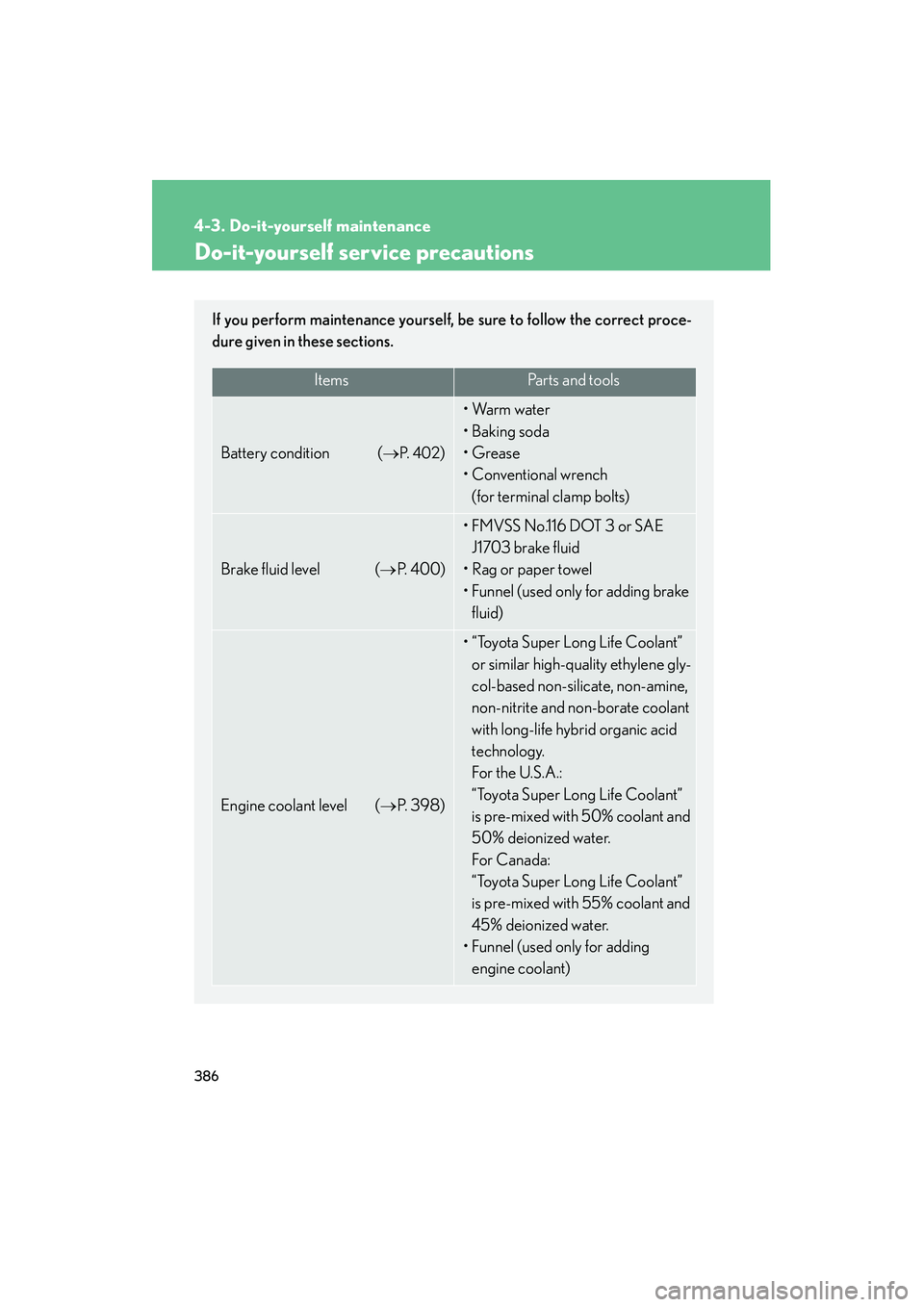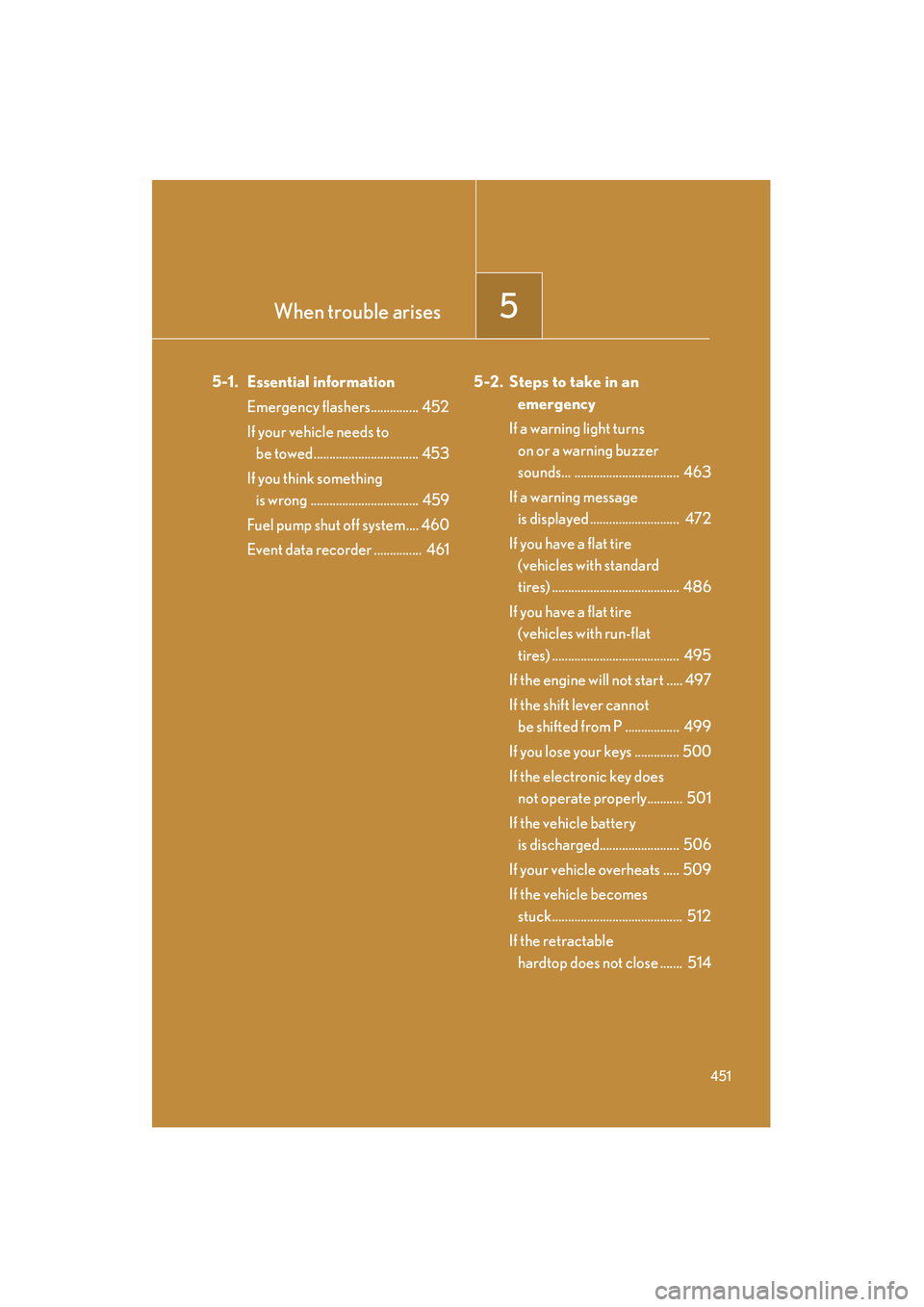tow Lexus IS250C 2010 Owner's Guide
[x] Cancel search | Manufacturer: LEXUS, Model Year: 2010, Model line: IS250C, Model: Lexus IS250C 2010Pages: 586, PDF Size: 31.62 MB
Page 225 of 586

224
2-5. Driving information
10_IS250C/350C_U
Trailer towing
Lexus does not recommend towing a trailer with your vehicle. Lexus also
does not recommend the installation of a tow hitch or the use of a tow hitch
carrier for a wheelchair, scooter, bicycle, etc. Your Lexus is not designed
for trailer towing or for the use of tow hitch mounted carriers.
Page 226 of 586

225
2-5. Driving information
2
When driving
10_IS250C/350C_U
Dinghy towing (vehicles with an automatic transmission)
NOTICE
■To avoid serious damage to your vehicle
Do not tow your vehicle with four wheels on the ground.
Your vehicle is not designed to be dinghy towed (with 4 wheels on the
ground) behind a motor home.
Page 227 of 586

226
2-5. Driving information
10_IS250C/350C_U
Dinghy towing (vehicles with a manual transmission)
Towing your vehicle with 4 wheels on the groundTo prevent damage to your vehicle, perform the following procedures
before towing. Shift the shift lever to neutral.
Switch to ACCESSORY mode. ( →P. 144)
Ensure that the audio system and other powered devices have been
turned off.
Release the parking brake.
After towing, leave the engine in idle for at least 3 minutes before driv-
ing the vehicle.
■Necessary equipment and accessories
Specialized equipment and accessories are required for dinghy towing. Contact
the service branch of the motor home manufacturer regarding recommended
equipment.
Your vehicle can be dinghy towed in a forward direction (with 4 wheels on
the ground) behind a motor home.
STEP1
STEP2
STEP3
Page 228 of 586

227
2-5. Driving information
2
When driving
10_IS250C/350C_U
NOTICE
■Dinghy towing direction
■To prevent the steering from locking
Ensure the “ENGINE START STOP” switch is in ACCESSORY mode.
Do not tow the vehicle backwards.
Doing so may cause serious damage.
Page 309 of 586

308
3-4. Using the hands-free phone system (for mobile phones)
10_IS250C/350C_U
■Conditions under which the system will not operate
●If using a mobile phone that does not support Bluetooth®
●If the mobile phone is switched off
●If you are outside service range
●If the mobile phone is not connected
●If the mobile phone's battery is low
●If the mobile phone is behind the seat or in the glove box or console box
●If metal is covering or touching the phone
■When using the hands-free system
●The audio system and voice guidance are muted when making a call.
●If both parties speak at the same time, it may be difficult to hear.
●If the incoming call volume is overly loud, an echo may be heard.
●Try to face toward the microphone as much as possible when speaking.
●In the following circumstances, it may be difficult to hear the other party:
• When driving on unpaved roads
• When driving at high speeds
•When a window is open
• When the air conditioning is blowing directly on the microphone
• When the air conditioning is set to high
■When transferring ownership of the vehicle
Be sure to initialize the system to prevent personal data from being improperly
accessed. (→P. 3 3 0 )
■About Bluetooth®
Bluetooth is a registered trademark of
Bluetooth SIG. Inc.
Page 371 of 586

370
3-7. Other interior features
10_IS250C/350C_UPress “AUTO” again.
If the direction is displayed several seconds after adjustment, the cali-
bration is complete.
■
Circling calibration
If “CAL” appears on the display,
drive the vehicle at 5 mph (8 km/h)
or less in a circle until a direction is
displayed.
If there is not enough space to
drive in a circle, drive around the
block until the direction is dis-
played.
STEP4
■Conditions unfavorable to correct operation
The compass may not show the correct direction in the following conditions:
●The vehicle is stopped immediately after turning.
●The vehicle is on an inclined surface.
●The vehicle is in a place where the earth's magnetic field is subject to interfer-
ence by artificial magnetic fields (underground car park/parking lot, under a
steel tower, between buildings, roof car park/parking lot, near an intersection,
near a large vehicle, etc.).
●The vehicle has become magnetized.
(There is a magnet or metal object near the inside rear view mirror.)
●The battery has been disconnected.
●A door is open.
Page 387 of 586

386
10_IS250C/350C_U
4-3. Do-it-yourself maintenance
Do-it-yourself service precautions
If you perform maintenance yourself, be sure to follow the correct proce-
dure given in these sections.
ItemsParts and tools
Battery condition ( →P. 4 0 2)
•Warm water
• Baking soda
•Grease
•Conventional wrench
(for terminal clamp bolts)
Brake fluid level ( →P. 4 0 0 )
• FMVSS No.116 DOT 3 or SAE
J1703 brake fluid
•Rag or paper towel
• Funnel (used only for adding brake
fluid)
Engine coolant level ( →P. 3 9 8 )
• “Toyota Super Long Life Coolant”
or similar high-quality ethylene gly-
col-based non-silicate, non-amine,
non-nitrite and non-borate coolant
with long-life hybrid organic acid
technology.
For the U.S.A.:
“Toyota Super Long Life Coolant”
is pre-mixed with 50% coolant and
50% deionized water.
For Canada:
“Toyota Super Long Life Coolant”
is pre-mixed with 55% coolant and
45% deionized water.
• Funnel (used only for adding
engine coolant)
Page 388 of 586

387
4-3. Do-it-yourself maintenance
4
Maintenance and care
10_IS250C/350C_U
CAUTION
The engine compartment contains many mechanisms and fluids that may move sud-
denly, become hot, or become electrically energized. To avoid death or serious injury,
observe the following precautions.
■When working on the engine compartment
●Keep hands, clothing, and tools away from the moving fan and engine drive belt.
●Be careful not to touch the engine, radiator, exhaust manifold, etc. right after driv-
ing as they may be hot. Oil and other fluids may also be hot.
●Do not leave anything that may burn easily, such as paper or rags, in the engine
compartment.
●Do not smoke, cause sparks or expose an open flame to fuel or the battery. Fuel
and battery fumes are flammable.
●Be extremely cautious when working on the battery. It contains poisonous and
corrosive sulfuric acid.
ItemsParts and tools
Engine oil level (→P. 3 9 5 )
• “Toyota Genuine Motor Oil” or
equivalent
• Rag or paper towel, funnel (used
only for adding engine oil)
Fuses (→ P. 4 2 7 )• Fuse with same amperage rating as
original
Tire inflation pressure ( →P. 4 1 6 )• Tire pressure gauge
• Compressed air source
Headlight aim ( →P. 4 4 2 )• Phillips-head screwdriver
Radiator and condenser ( →P. 4 0 0 )
Wa s h e r f l u i d ( →P. 4 0 5 )
• Water washer fluid containing anti-
freeze (for winter use)
•Funnel
Page 452 of 586

When trouble arises5
451
10_IS250C/350C_U
5-1. Essential informationEmergency flashers............... 452
If your vehicle needs to be towed................................. 453
If you think something is wrong .................................. 459
Fuel pump shut off system.... 460
Event data recorder ............... 461 5-2. Steps to take in an
emergency
If a warning light turns on or a warning buzzer
sounds... ................................. 463
If a warning message is displayed ............................ 472
If you have a flat tire (vehicles with standard
tires) ........................................ 486
If you have a flat tire (vehicles with run-flat
tires) ........................................ 495
If the engine will not start ..... 497
If the shift lever cannot be shifted from P ................. 499
If you lose your keys .............. 500
If the electronic key does not operate properly........... 501
If the vehicle battery is discharged......................... 506
If your vehicle overheats ..... 509
If the vehicle becomes stuck......................................... 512
If the retractable hardtop does not close ....... 514
Page 454 of 586

5
When trouble arises
453
5-1. Essential information
10_IS250C/350C_U
If your vehicle needs to be towed
Before towingThe following may indicate a problem with your transmission. Contact
your Lexus dealer before towing.
● The engine is running, but the vehicle will not move.
● The vehicle makes an abnormal sound.
Emergency towing
If a tow truck is not available, in an emergency your vehicle may be tem-
porarily towed using a cable or chain secured to the emergency towing
eyelet(s). This should only be attempted on hard, surfaced roads for short
distances at low speeds.
A driver must be in the vehicle to steer and operate the brakes. The vehi-
cle’s wheels, drive train, axles, steering and brakes must be in good condi-
tion. Towing eyelets
If towing is necessary, we recommend having your vehicle towed by your
Lexus dealer or a commercial towing se rvice, using a lift-type truck or a flat
bed truck.
Use a safety chain system for all towing, and abide by all state/provincial
and local laws.
If towing from the rear, the vehicle’s front wheels and axles must be in good
condition. ( →P. 4 5 7 )
If they are damaged, use a towing dolly or flat bed truck.